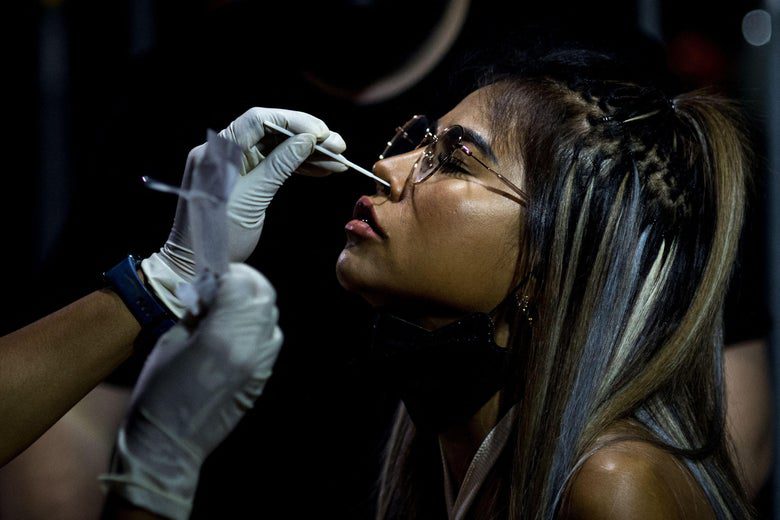As I am writing this sentence, I have my phone sitting next to me, waiting for a photo to pop up in my family group chat. We’re all eager for the results of a rapid test that my brother just took.
Last week, one of his coworkers at the auto body shop tested positive for COVID. On Monday, a second coworker tested positive. My brother is symptomless, and going into work, but testing daily right now. This could easily cost us $100 for a week—the length of time that the Centers for Disease Control and Prevention recommends vaccinated folks test after a COVID exposure—as over the counter rapid tests have typically run $24.99 per box at CVS or Walgreens (though there are deals to be found).
We’re a multigenerational home, and that $100 is a hunk of our budget, that needs to go to school shoes for my little brothers; it represents a month’s worth of gas to get to work. And if my brother tests positive, in addition to other worries and expenses, the four other members of my family will need to test multiple times as well. Frankly, the only way that following the testing guidelines is financially feasible for us is because we received free at-home COVID tests from the state of Colorado, through their Rapid At-Home Testing Program.
On Monday, a clip from White House Press Secretary Jen Psaki went viral, because of an exchange involving free rapid tests. Mara Liasson of NPR asked Psaki why the United States doesn’t just make the home COVID-19 tests free or reduced cost for everyone. “Should we just send one to every American?” Jen joked, with a smile that I read as flippant, and even scornful. “How much does that cost, and then what happens after that?”
It is true that mailing a single test to every American would be kind of silly, and expensive (that’s why they should be sending many tests—as for the cost, we’re in a pandemic!) . Other countries already doing it. As is Colorado, where I live. I think my state’s efforts are proof that others—and maybe even the American government—can do exactly a good and useful version of what Psaki was laughing off.
Here is how getting rapid tests works for me: I go online, and fill out a form saying that I’m a resident of Colorado. Twenty-four to 48 hours later I get an email asking me to fill out a second form. Then I go back to that second form and enter in a one-time code that is emailed to me. Annoying steps, to be sure, but ones that take only a couple minutes to complete, and at the end of this little dance, I get free COVID tests. No insurance required, no reimbursements to navigate, no running around town trying to find a pharmacy that has them in stock. (And, for people in pharmacy deserts—no need to haul a long way pharmacy). They show up on my doorstep a few days later, along with an email reminding me to bring them inside right away, since they’re temperature sensitive. Every individual in Colorado can request up to eight tests per week, should they need them.
My brother can go to work each day knowing that he has tested negative, and that his coworkers have had the ability to test, as well. The proliferation of rapid tests can make the difference between going to work, or losing out on a paycheck because the infection has spread unchecked and too many employees are out sick to keep the doors open. If everyone has access to rapid tests, and is able to take them even in situations where it’s just a precaution—for example, before heading to a family gathering—Colorado’s program can be the difference between an infection spreading unknown and unchecked and being able to catch it before it burns through whole households and communities.
Of course rapid tests aren’t a panacea for coronavirus—but health experts have been saying for a long time that they help, especially if everyone has access to them. Watching the clip of the press conference, I wanted a journalist to look Jen Psaki in the eye and ask her why the federal government can’t follow Colorado’s lead and institute a similar program nationwide. Access to tests shouldn’t depend on a person having money to spend on them, or insurance plus spare time to get them reimbursed—or being lucky enough to live in Colorado.
When the results come in, my brother’s message bubble pops up on my screen, “Negative. Thank God. I’m going back to work.”
This content was originally published here.

